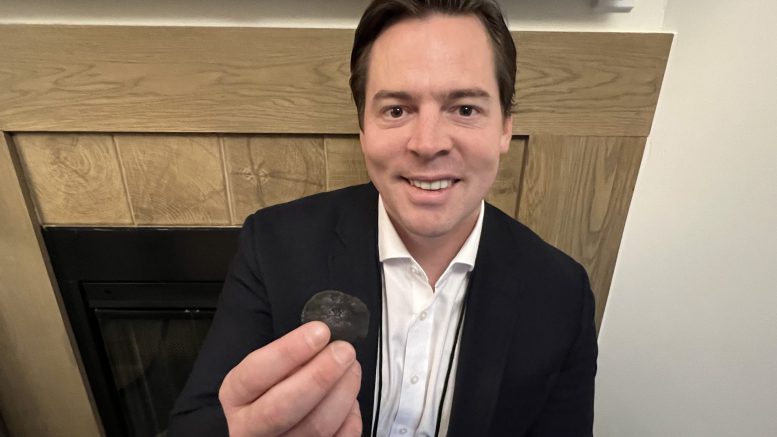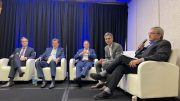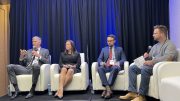In the dark waters of the abyssal plain between Mexico and Hawaii lies the expansive Clarion Clipperton Zone (CCZ), where Canadian outfit The Metals Company (NASDAQ: TMC) plans to pioneer commercial polymetallic deep-sea mining by late 2025.
TMC’s subsidiary, Nauru Ocean Resources (NORI), intends to apply for a deep-sea mining permit to the International Seabed Authority (ISA) after the organization’s next meeting in July 2024, chief financial officer Craig Shesky told The Northern Miner during a recent industry conference.
Although the ISA hasn’t finalized mining rules, a loophole could allow the world’s first deep-sea mining operations to start as early as next year.
With near-term production in sight and freshly invigorated by a US$27 million capital injection in August, Shesky said the company would not wait on the ISA to finalize its rulebook. “Whether they’ve finalized what the legal framework for deep-sea mining will look like or not, we have the legal right to launch our permit application, meaning they‘d have to consider and provisionally process it,” Shesky said, noting strong interest from the investment community displayed during the recent registered offering.
NORI conducted a successful test last fall, collecting over 3,000 tonnes of polymetallic nodules. However, the company has been criticized for its environmental risk management practices after a leaked video late last year showed waste sediment being dumped into the ocean. An ISA investigation found no rule breach but criticized NORI’s ‘risk awareness,’ citing the company’s failure to follow its own risk management procedures.
Environmental groups and some countries call for a halt or ban on deep-sea mining, warning of unacceptable risks to marine life and ecosystems. A recent report also suggests that the environmental costs of seabed mining could outweigh the benefits.
According to Shesky, the company is responding to allay stakeholder fears via a partnership with Kongsberg Digital signed early this month. The agreement has led to developing a ‘digital twin’ concept — a core component of the company’s broader Adaptive Management System. This digital counterpart integrates multiple data streams from The Metals Company’s future production system and enables three-dimensional visualization of its deep sea operating environment above water.
“The technology serves as ‘eyes and ears’ for regulators and stakeholders, providing near-real-time insights into operations and environmental impact,” Shesky said.
The Metals Company has also taken a significant step toward environmental stewardship by becoming the largest Ocean Biodiversity Information System contributor. This level of transparency will make Nori Area D one of the most highly characterized deep-sea areas in the nodule exploration region.
The Metals Company has exclusive access to the NORI project, 4,000 metres deep in the northeastern Pacific Ocean. The advanced exploration project is ranked as the world’s biggest undeveloped nickel project, according to The Northern Miner’s data provider Mining Intelligence, with an estimated 866 million wet tonnes of nodules grading 29.5% manganese, 1.3% nickel, 1.1% copper and 0.2% cobalt.
Nauru Ocean Resources, a subsidiary of TMC, formerly Deep Green Metals, holds the exploration contract.
The Metals Company also acquired Tonga Offshore Mining Ltd. in 2020, giving the company exploration rights to a 74,713-sq.-km block of CCZ seabed that contains an inferred resource of 756 million wet tonnes of polymetallic nodules.
Harvesting the deep
Polymetallic nodules, also called manganese nodules, contain four essential battery metals: cobalt, nickel, copper and manganese, in a single ore.
Formed over millions of years by precipitating metals from seawater and sediment pore water, these nodules lie unattached to the abyssal seafloor. Unlike land ores, nodules do not contain toxic levels of heavy elements, and producing metals from nodules has the potential for the company to process nearly all of the nodule mass and design a metallurgical flowsheet that generates no tailings and leaves almost no solid waste streams.
Shesky says nickel from NORI-D nodules could have lower impacts than compared land-based production routes across every category of ESG benchmarking. The company uses a non-invasive mining approach that doesn’t require drilling or blasting.
The Metals Company plans to lift polymetallic nodules to the surface, take them to shore, and process them with near-zero solid waste, no tailings or deforestation, and with careful attention not to harm the integrity of the deep-ocean ecosystem.
Its production process begins with the collector, designed to collect polymetallic nodules from the abyssal seafloor. Over 90% of the entrained sediment is expected to be separated from the nodules inside the collector and discharged behind it, with most sediment settling back to the seafloor within a few hundred metres. From the collector, nodules travel up a riser system to the production vessel. Once aboard, nodules get dewatered and residual water, sediment and nodule fines will be returned below the photic zone to a depth scientifically chosen to have minimal impact on the collection area.
The nodules are then expected to head to shore, where they’re offloaded for processing.
The Metals Company collaborates with respected institutions like MIT to study the environmental impact, particularly the sediment cloud, known as the plume, stirred up during mining. Current research shows that 92-98% of this plume resettles within hours, indicating a minimized impact on the surrounding ecosystem, according to Shesky.
Regulatory showdown
Even before starting commercial operations, the company is already focused on ramping up productivity. Shesky says that in collaboration with their strategic partner, Allseas, they have significantly enhanced the projected production capacity of their innovative Project Zero Offshore System.
Utilizing the Hidden Gem vessel, the system’s capacity is expected to soar by 130%, reaching 3 million wet tonnes from the initially planned 1.3 million tonnes.
Efforts to establish a robust regulatory framework for deep-sea mining are gaining momentum. The ISA council shows a high level of collaboration and has laid a roadmap to continue finalizing the Mining Code. This aligns with TMC’s support from U.S. Congressional leaders urging the Biden Administration to investigate the domestic processing of seafloor polymetallic nodules.
Shesky summarizes the company’s approach as a careful balance between various stakeholders. “Getting the industry started, showing that we can do this responsibly and commercially—these are the challenges we’re addressing,” he stated.





Be the first to comment on "Navigating the deep: The Metals Company eyes late 2025 ocean mining start"